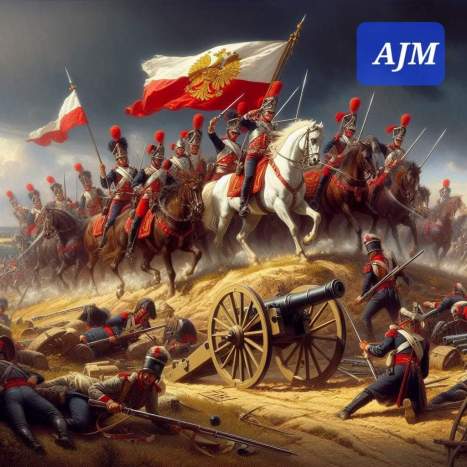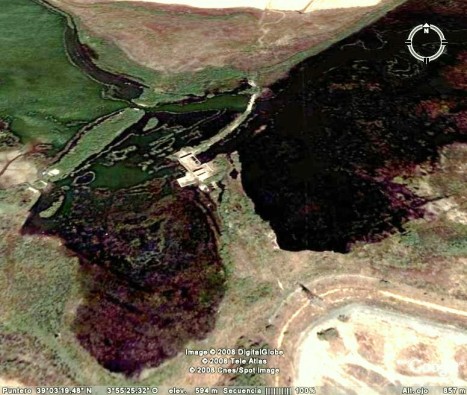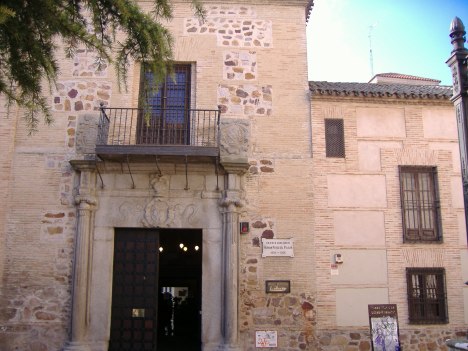In the year 1809, Spain was almost occupied by Napoleon’s Imperial Armies.
The Napleon’s Army was defeat by Spanish’ s army on July 19th 1808 in Bailén.
Napoleon was a great victory against the Spanish Army in the battle of Madrid on December 1808.
Napoleon’s troops continue they advance on the south of Spain just at the city of Cadiz.
The Battle of Ciudad Real (26–27 March 1809) was fought just a 7 kilometers the town of Ciudad Real, Spain some 180 kilometers southwest of Madrid, during the Peninsular War. At Ciudad Real a Spanish army under General Urbina in operations against French-occupied Madrid.
After Marshal Victor French army victory in Somosierra Battle, General Urbina’s 10,000 Spanish troops advanced into La Mancha, they marched up the Guadiana valley to Ciudad Real, only 120 kilometers to Toledo. There they encountered 15,000 French under Lieutenant General Horace Sebastiani,

On March 26 of 1809 there was The Battle for «La Mancha» province in Ciudad Real, near Toledo. The French troops were approaching from the north toward Ciudad Real, came from Consuegra village in pursuing spanish Army after the battle of Los Yébenes on March 24.
The French Imperial Army are a combined multinational force, with Better of the Storm Troops of Europe, especially their excellent Cavalry Polish Lancers of the Vistula, Commanded by General Sebastiani;
The Spanish Army, have were defeated in the battles of Uclés and Consuegra with poor trained and demoralized troops and an obsolete weaponry, there are the Line Regiments and the Militia of Ciudad Real, under the Command of Liutenant General Jose de Urbina, Count of Cartaojal.
Armies:
France: 4th Army Corps by Lieutenant General Horace Sébastiani:
12 infantry bataillons, 8000 troops 10 cannons.
Major General Milhaud: 2nd Division of Dragoons Cavalry Reserve: 24 Squadrons 1st, 2nd, 4th, 9th, 4th, 20th and 26th Dragoons. Totally: 4,500 troops.
IV Corps Cavalry: 4 squadrons, the 3rd Dutch Hussars and 7th Polish Lancers Regiment of Vistula Legion. Totally: 1,000 troops.
Totally: 10.500 troops.
– Spain: Army of La Mancha by the Lieutenant General José de Urbina y Urbina, Count of Cartaojal.
Major General Juan Bernuy y Fernández de Córdoba:
Cavalry: Regiments Carabineros Reales, España, Príncipe, Sagunto, Pavia.
Major General Joaquín Crespi Valdaura.
Infantry: regiments Guadix, Loja, Ciudad Real and Chinchilla Militia Infantry.
Major General Joaquin Ibarra Labiano 1st Artillery Brigade 10 cannons.
Totally: 8,500 troops.
Since 10 a.m. of march 26, in a rainy and cold morning the French Cavalry Division of General Milhaud came from Peralbillo, a small village near Ciudad Real to Guadiana brigdes 8 km near Ciudad Real, but they was defeated in his attempt to cross those Guadiana bridge to Ciudad Real, having passed the Bridge Nolaya with 1,000 cavalry troops and 4 cannons a charge from the Spanish cavalry made them had to cross the bridge Nolaya Bridge towards the small village of Peralbillo 8 km at the north of Ciudad Real at the end of this day.
During the first day of the Battle of Ciudad Real on March 26, 1809 the IV Army Corps concentrated its efforts against the Spanish Squadrons whom defended the brigdes of Guadiana, so Urbina’s troops survived the fate of Somosierra’s battle. With several oficiers seriously wounded, and most of the spanish Squadron’s lost, Lieutenant General Venegas took over command. After facing repeated Napoleonic cavalry and infantry attacks during the evening, the remaining spanish troosp assembled around La Atalaya Hill.
However, even the French army had crossed the Guadiana in the middle of the rain of dawn on 26 March. Through the Guadina bridges near Ciudad Real , the French army attacked the right of the Spanish army and the also the left. A strategic bridge of Molino del Emperador was taken and lost 2 times, until, finally, the Spanish held it firmly.

At daybreak on 27 March, the French attacked the Spanish army right again to take the hill of La Atalaya and retake the bridge of Molino del Emperador and were repulsed when the Carabineros cavalry regiment and Ciudad Real Milita Regiment who had been shelling behind the crest stood up and carried out a bayonet charge and cover the retreat to the forest in the skirts of La Atalaya hill in the road of Cordoba. A French massive infantry charge after a cannonade lasted until noon when Lieutenant General Jose de Urbina ordered the Spanish withdralw to mountains near Jaen.

With strengthening Regiments Frech 4th Army Corps, the 20th Dragons Regiment arriving enabled them fortified the «Molino del Emperador» bridge on Guadiana river, which surprised entirely to device Spanish dispositive, thus all that day the Spanish army and the only one of the 3 provincial militia Regiments, such as Ciudad Real, resisted the thrust of much higher number in the French army Nolaya Bridge on the River Guadiana and drove the French army from the Emperor’s Mill Bridge after this the French troops withdrew to Peralbillo and Spanish after leaving a guard at the 4 cannons Guadiana bridge and them retreated to Ciudad Real.

Afterall, on March 27th, 1809 had place the decisive battle between the Spanish troops and Napoleon’s army in the shores of the Guadiana River for the control of the Nolaya Bridge, after Lieutenant General Horace Sébastiani sent his infantry across the bridge. This threatened to outflank the Spanish right wing the advance of French infantry was rejected again by the 4 cannons placed in the 2 bridges, the Polish Cavalry regiment of General Milhaud had crossed the bridge over the Guadiana River near the Calatrava castle and got wrapped by surprise appearing behind the Ciudad Real and others infantryt regiments that was not even in battle formation to repel the attack which was quickly rounded up by their flanks, them escape toward the nearest hill of La Atalaya because in its skirts had a forest.

The Atalaya Hill, 3 kilometers near Ciudad Real town.
Meanwhile, the French infantry has avanced in waves from Peralbillo highs and striked with their numerical and tactical superiority the Spanish troops wich defending the Nolaya bridge fell after the infantry had fallen back to the nearby hill of La Atalaya, the Cavalry Regiment Carabineros Reales protected the withdrawal of the troops to the village of Almagro. At noon Frenchmen reached Ciudad Real where finished the last resistance of the Spanish troops barricaded in their walls. After that, General Cartaojal has ordered a withdrawal to the village of Viso del Marqués about 60 kilometers from Ciudad Real.
In this battle was desbanded the Ciudad Real Militia Regiment, losing so far a company.
The spanish Army had several casualties, over wounded, prisoners and missing in action the following casualties: 1 colonel and 47 gunners killed, 2000 infantry troops killed. Prisoners: 36 officers and 2,000 troops, 5 canons, 1 howitzer and 3 banners, including the flag of Ciudad Real’s Militia regiment, also half ot the spanish army of La Mancha military equipament like artillery chariots.
General Urbina was not taken as a prisoner of war, but he was dishonorably discharged by the Spanish Army Command, Lieutenant General Castaños, and stripped of his Command, were arrested in a castle and taken before a court martial in 1810. His Second-on-Command, General Venegas was promoved to Commander of the army of La Mancha and in may of 1809 he tried to retake Ciudad Real without any chance.
General Sébastiani, was honored with a place in the Arch of Triumph in Paris.
The Napoleon’s Army suffered almost 100 casualties betwen killed and wounded.
In the two days of fighting there were around 500 either killed, wounded, or missing in action from both sides.
At 2 afternoon March 27 French troops held Ciudad Real, the 3rd Hussars of Holland takes the control of this town, with her Colonel Baron Anton Roest d’Alkemade wounded in action near La Atalaya hill during his regiment charge against spanish infrantry.

Residence Palace of Colonel Roest D’Alkemande in Ciudad Real
Most part of the French occupation troops has removed to the villages of Miguelturra and Almagro. Before, the French General in Command, Horace Sebastiani, waited at the Puerta de Calatrava in Ciudad Real that came out to beg for mercy and not to destroy the town or take hostages, as was the military custom of the time, a small group of Ciudad Real citizens, as the vast majority had fled for fear of the neary mountains, including many of the leading men and politicians, came to ask for mercy and take no account of the battle, to which the French general agreed.
A little part of the occupation troops stay in Ciudad Real in a detachment and Depot, here began the French occupation of Ciudad Real. The 3rd Hussars of Holland, was using like the Barracks the former Hospital de la Caridad (Charity Hospital) in Ciudad Real.
The 16th Dragoons were others Regiments by the French Imperial Army which occupied the Hospital de la Caridad in Ciudad Real.
To counteratack the French Ocupattion, in the year 1811 is formed a spanish Squadron of Hussars, with people of Ciudad Real and Miguelturra whom try to retake Ciudad Real and make the guerrilla actions against the French occupation troops.
A British Officer, Colonel Andrew Leith entered in Ciudad Real the February 12, 1813 in a advance exploration and wrote this: «Ciudad Real, located on a plain of great extent, in the center of a highly cultivated region, is a beautiful city, containing a large population. The buildings are large, wide and straight streets, the city is surrounded by an old wall and has eight convents and a hospital. The province of La Mancha produces wheat, wine and oil in abundance and therefore was a favorite of the French Army, for many months supplied the needs of the army of Marshal Soult».
The Duke of Wellington was honoured and awarded in Ciudad Real in 1811.
FOR MORE INFORMATION READ THE BOOK:
«NAPOLEON EN LA MANCHA, 2009.
To buy the book:
http://www.lulu.com/browse/preview.php?fCID=7038055
To read the version of the Polish Lancers:
http://wapedia.mobi/pl/Bitwa_pod_Ciudad_Real
VERSION FRANÇAISE:
https://ciudadreal.wordpress.com/wp-admin/page.php?action=edit&post=343&message=5
EN ESPAÑOL:
https://ciudadreal.wordpress.com/wp-admin/page.php?action=edit&post=348&message=5


Deja un comentario